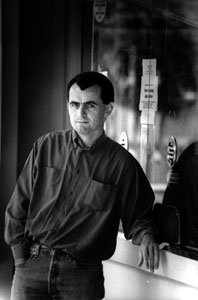|
HOME | SEARCH | ARCHIVE |
|
Professor uses movie special effects to teach mechanical engineering principles
By Cathy Cockrell, Public Affairs
| |
|
01 NOVEMBER 00 | Learning the basics of mechanical engineering can be as pleasurable as an afternoon at the movies.
That's the secret of Professor Oliver O'Reilly's freshman seminar, "Mechanics and the Movies," in which prospective engineers cue up "Star Trek," "The Matrix" and the adventures of James Bond to examine forces, motion and falling particles.
"We look closely at the mechanics involved in animating reality, from the tornadoes in 'Twister' to the physics of shooting pool in 'The Hustler' to the meteor showers in 'Armageddon,'" says O'Reilly, a recent recipient of Berkeley's Distinguished Teaching Award. "We want to analyze each situation to ask how realistic the scenes are from a mechanics perspective. If Hollywood gets it right, we want to know how they did it."
For their first project this semester, students were required to collaborate in analyzing the mechanics of a movie scene of their choosing. One group selected a dramatic moment in the James Bond's "The World is Not Enough."
"We chose the first action scene we viewed, because it was so fake that we laughed at it," said freshman Jaime Herren.
In that scene, Agent 007 shoots a crooked accountant, grabs a rope that has appeared out of nowhere, ties one end to his own belt and the other to his wounded opponent, jumps from a fifth-story window and falls for 6.5 seconds until he is jerked to a halt, unscathed, 10 to 20 feet above the ground.
By timing the escape, estimating distances, correcting each other's assumptions and calculated forces, the students concluded that James Bond would have fallen 676 feet in the 6.5 seconds he was in free fall, and that the rope attached to his belt absorbed more than a ton of force - enough to slice a normal man in half.
Freshmen get excited about applying mechanical engineering principles to a 007 escape or Harrison Ford's jump off a 200-foot dam in "The Fugitive," rather than hypothetical problems solved in clouds of chalk dust.
"You see that ... engineers are the ones that design and produce the most exciting parts of movies," said Herren, one of several women students in the seminar. "Before this class, I never would have associated movies with engineering. And I would have missed out on a whole branch of career opportunity."
"Instead of just memorizing formulas, you apply them to real life in the movies," said student Steve Kang, whose group dissected a chase scene and explosion in the Sean Connery, Nicholas Cage action film, "The Rock." "Whoever takes this class, it's harder to fool them with special effects."
O'Reilly encourages students to view films' captivating special effects in terms of Newton's laws - without losing their appreciation for the movie experience.
"I don't want this to be a nay-saying class about the movie industry," O'Reilly said. "'Star Wars,' all of these movies, get you to believe in another world. If they succeed in getting us to suspend our disbelief, it's amazing."
His own love affair with celluloid began early - as a child growing up in a small town in western Ireland.
"Censorship was alive and well," O'Reilly recalls, and youth under 18 weren't permitted to see a movie like "Alien."
All that changed with the advent of VCRs and videos, which were less strictly regulated than films at the local cinema. Scores of formerly forbidden flicks were suddenly his for the renting - and a lifelong passion got its start.
"There were periods in my life when I watched up to 10 movies a week," O'Reilly says. "Between bargain matinees and late-night TV, you can see a lot of movies. I enjoy the emotional roller coaster that you go on."
With rod theory and engineering dynamics filling out the rest of his teaching schedule, "Mechanics and the Movies" is "like being in a candy store," says O'Reilly. "You get to watch scenes again and think about them in another way" - while learning new things related to engineering, even as the teacher.
"Sometimes what the students do surprises you," he says. "They know things about driving cars or flying airplanes that you don't know anything about. "Students like movies," and they're interested in how linear algebra, calculus and mechanical principles can be applied, says O'Reilly. "It's a slam dunk if you try to bring those two together."
Home | Search | Archive | About | Contact | More News
Copyright 2000, The Regents of the University of California.
Produced and maintained by the Office of Public Affairs at UC Berkeley.
Comments? E-mail berkeleyan@pa.urel.berkeley.edu.
